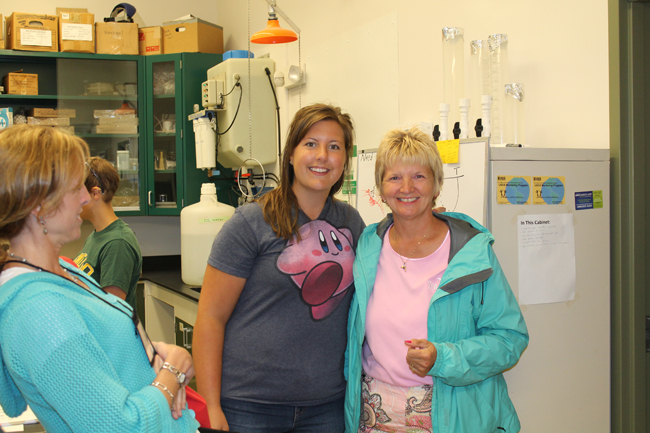
Former New York Sea Grant Steward Program student Stacy Furgal (left) is
now employed as a USGS Technician. She is seen here with tour leader
New York Sea Grant Coastal Education Specialist Helen Domske. Photo: NY Sea Grant/Kara Lynn Dunn
Syracuse, NY, August 12, 2013 - While their students enjoy summer vacation, 12 science teachers, two special education teachers and one high school librarian from across New York State spent a week learning about the ecology of Lake Ontario.
The grade 5-12 educators from 13 school districts were part of the Great Lakes Field Experiences Lake Ontario Workshop for watershed educators led by New York Sea Grant Coastal Education Specialist Helen Domske.
“This workshop is designed to help promote the stewardship, protection and restoration of coastal areas by sharing meaningful watershed system experiences with teachers that they can use to inspire their students,” Domske
The workshop used the principles of Excite, Explore, Explain, Elaborate,
and Evaluate for focusing on Great Lakes watershed curricula from the National Oceanic and Atmospheric Administration (NOAA)
and other sources.
The 4-day workshop included sessions at SUNY Oswego, the Salmon River
Fish Hatchery in Altmar, the Lake Ontario dunes system in Oswego and
Jefferson counties, the U.S.Geological Survey (USGS) Lake Ontario Biological Field Station in
Oswego, and the Cornell University Biological Field Station in
Bridgeport.
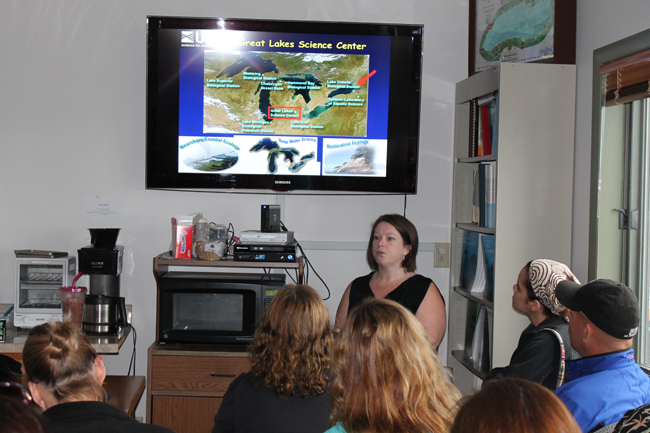
USGS Research Scientist Dr. Maureen Walsh provided the teacher group
with an overview of the work conducted out of the USGS Lake Ontario
Biological Station at Oswego, NY, and throughout the Great Lakes system.
Photo: NY Sea Grant/Kara Lynn Dunn
Dr. Maureen Walsh, one of three research scientists at the USGS Lake Ontario Biological Field Station, provided the group with an overview of the scope of research being conducted there.
“Our research is focused on Great Lakes ecology. This year we have a new collaborative project assessing the entire food web from bacteria to top predators like salmon. The staff here are involved in fish diet studies, tracking restoration of native fishes, and assessing the impact of invasive species,” Walsh said.
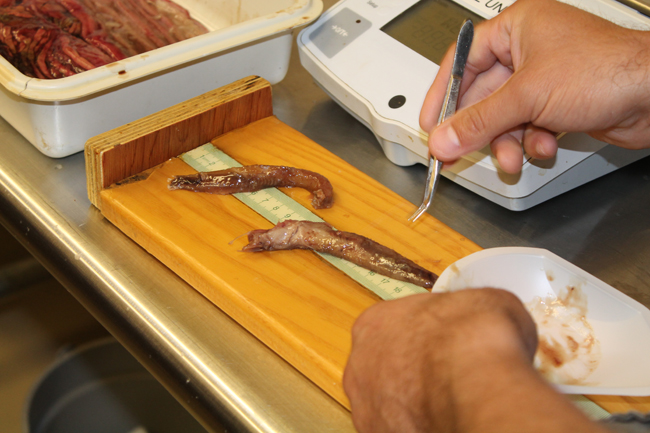
USGS Technician Chris Legard prepared fish stomachs for the teachers to
dissect to learn about fish diets. Some of the fresh contents were not
yet digested. Photo: NY Sea Grant/Kara Lynn Dunn
Captain Terry Lewchanin and Chief Engineer Ted Strang provided the teachers with a tour of the station’s 70-foot research vessel used for day and night sampling on the lake.
“I have learned some really neat hands-on ideas to take back to my classes for interdisciplinary study,” said Kimberly Preshoff of Williamsville North High School. “We talk a lot about the worldwide picture; this workshop is perfect for helping our students understand the local environment and that they can make a difference right here at home.”
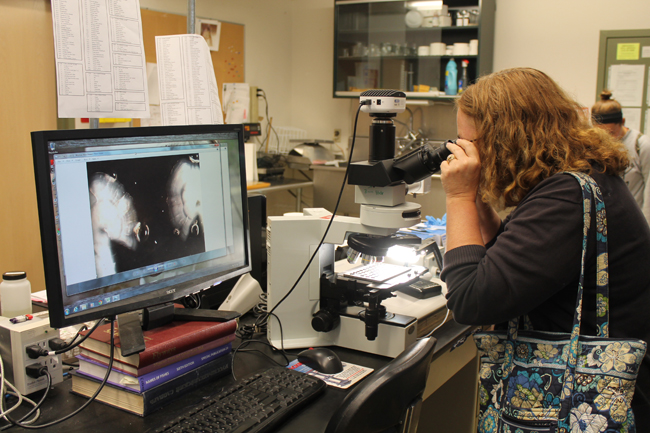
The teacher group viewed fish otoliths under the microscope in the USGS Lake Ontario Biological Station lab. Otoliths, which help biologists to determine age and derive age-related information as well as growth rates of various fishes, are hard, calcium carbonate structures located directly behind the brain of bony fishes. Photo: NY Sea Grant/Kara Lynn Dunn
Living Environment teacher Timothy Lanighan of Newfane High School, a district in Lake Ontario/18 Mile Creek area, said, “This workshop provides resources, ideas and contacts that will help the development of Newfane’s new environmental science advanced placement curricula.”
Jeffrey Orman from Honeoye Central School in Hemlock, NY, has conducted water testing on Mill Creek just 500 yards from his classroom. He enjoyed the opportunity to explore the natural and manmade resources in the Lake Ontario region.
“It was neat to visit the eastern Lake Ontario dunes which I did not know about and to see the (Salmon River) fish hatchery in operation,” he said.
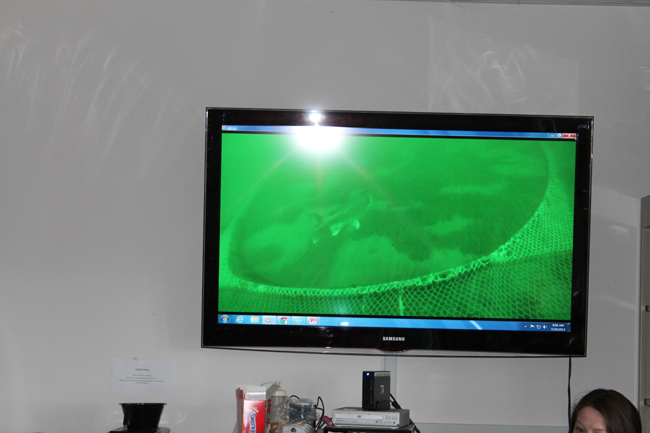
The New York Sea Grant Lake Ontario Workshop group saw a video of sampling by the new USGS R/V Kaho. Photo: NY Sea Grant/Kara Lynn Dunn
Cheryl Philllips, a Springville High School Librarian, added that, “Participating in the workshop will allow me to bring additional non-fiction informational text resources to our science and ag-tech teachers, along with the opportunity for the classes to utilize a hydro lab.”
As the Springville District representative for the Erie 2 BOCES School Library System, which promotes cooperative collection development and access to specialized resources among the librarians from 27 component districts, Philipps will present information about the New York Sea Grant Great Lakes teachers workshop at an upcoming meeting.
Liz Parra, a Special Education teacher at Brocton Central School, whose class will be moving on to high school this year, said, “This workshop is helping me to develop hands-on activities that will help my students understand science concepts related to the local environment.”
Teachers interested in participating in the 2014 Lake Ontario learning week can contact Helen Domske, NYSG Coastal Education Specialist, E: hmd4@cornell.edu, P: 716.645.3610.
Funding for this workshop was provided by NOAA's Bay Watershed Education and Training (B-WET) is an environmental education program that promotes locally relevant, experiential learning in the K-12 environment. The primary aim is to promote environmental literacy in society, supporting individuals to understand, protect and restore watersheds and related ocean, coastal, and Great Lakes ecosystems.
— By Kara Lynn Dunn